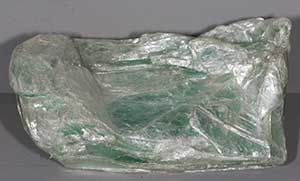 |
| Talc - Mg3SI4O10(OH)2. |
Talc is a hydrous magnesium silicate. Soapstone and steatite are two varieties of massive talc, which means that the crystals cannot be seen easily without a lens or microscope. Talc is used commercially because of its fragrance retention, luster, purity, softness, and whiteness. Other commercially important properties of talc are its chemical inertness, high dielectric strength, high thermal conductivity, low electrical conductivity, and oil and grease adsorption. Its main uses are in ceramics, paint, paper, and plastics. Talc was mined in five States in 2002 and eight States in 1997.
Background
Two different minerals with similar physical properties are talc and pyrophyllite. Their physical properties are nearly identical. Both are very soft: talc is the softest mineral on the Moh's hardness scale at 1, and pyrophyllite is 1 to 2. Because they are so soft, they can be easily cut and crushed. Archaeological discoveries have shown that talc was carved in ancient Babylonia to make signature seals. Chinese "soapstone" carvings are carved from fine-grained pyrophyllite.
Both talc and pyrophyllite have perfect cleavage in one direction. This means that these minerals break into thin sheets. As a result, both feel greasy to the touch (which is why talc is used as a lubricant). They are both formed in metamorphic environments as the result of changes in silica-rich dolomite.
Steatite and soapstone are impure, massive forms of talc that lack the distinctive cleavage mentioned above.
Name
The name talc is thought to be derived from the Arabic word talg or talk meaning mica since talc forms mica-like flakes. In other words, it displays micaceous cleavage. The name in its present form was given by Georgius Agricola in 1546.
The name pyrophyllite comes from the Greek words pyr meaning fire and phyllon meaning leaf, a reference to the fact that it flakes when heated. The name was given by R.
Sources
There are numerous talc and pyrophyllite resources worldwide. The United States produces enough talc and pyrophyllite to meet its annual needs. Of the seven states producing talc, most is mined in Montana, New York, Texas and Vermont. All the pyrophyllite produced in the United States is mined in North Carolina. Despite the volume of talc/pyrophyllite produced domestically, some is imported from China , Canada, Japan, and other countries. Of the countries importing U.S.-produced talc, Canada is the largest importer.
Unlike other commodities, talc and pyrophyllite are not recycled.
Uses
Ground talc is used as an ingredient in ceramics, paper, paint, roofing, plastics, cosmetics such as talcum and baby powders, and a variety of other assorted uses such as making rubber and plastics.
Ground pyrophyllite is used in the production of ceramics, heat-resistant products called fractories, and paint.
Soapstone was once used to make chemical-resistant sinks and countertops for laboratories. Before the days of furnaces, blocks of soapstone were heated on stoves and used as bed warmers.
Substitutes and Alternative Sources
Clays and pyrophyllite can be used in place of talc in the manufacture of ceramics. Kaolin (a clay mineral) and mica can be substituted for talc in the production of rubber, paint, and plastics. Kaolin can be used in place of talc in paper production. The available reserves of talc are sufficient for many decades to come so such substitutions are not necessary, though they may be cost-effective depending on the relative costs of talc, mica, pyrophyllite and kaolin.